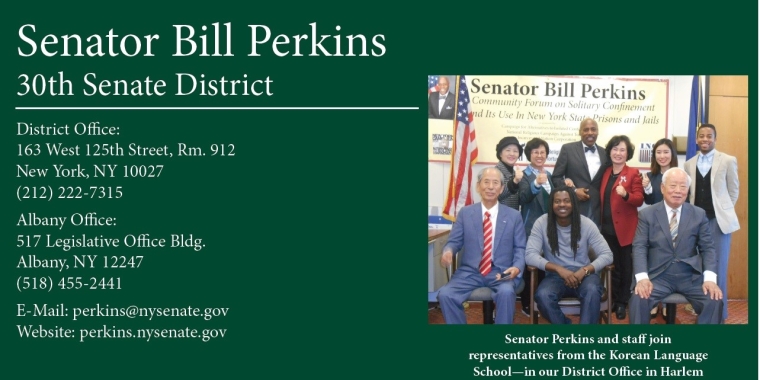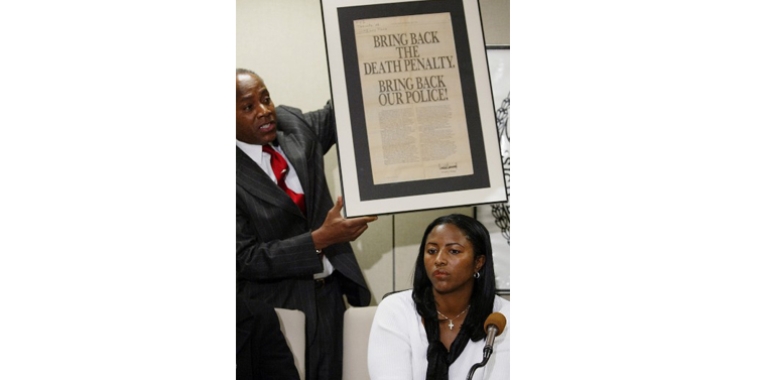Letter to Governor Paterson: Challenges the Legality of the Brooklyn Arena LDC's Bond Issuance
Bill Perkins
December 20, 2009
-
ISSUE:
- Economic Development
- Corporations
- ESDC (Empire State Development Corporation)
- Community Development
-
COMMITTEE:
- Corporations, Authorities and Commissions
December 18, 2009
Hon. David A. Paterson
Governor, State of New York
State Capitol
Albany, New York 12224
Dear Governor Paterson:
On Tuesday, December 15, 2009, the Brooklyn Arena Local Development
Corporation (BALDC) sold $511 million of tax exempt bonds to help finance
the Atlantic Yards arena. BALDC is a not-for-profit corporation and was
created by the Job Development Authority under section 1411 of the
Not-For-Profit Corporation Law. The Job Development Authority (JDA) is a
mostly defunct public authority that exists, along with the Urban
Development Corporation, as part of Empire State Development Corporation
(ESDC).
It appears that ESDC chose to have the JDA create the BALDC so as to avoid
creating an ESDC subsidiary, which would have required approval from the
Public Authorities Control Board (PACB) and the Comptroller to issue the
arena bonds. Pub. Auth. § 51. PACB approval in this case would have been
disadvantageous for two reasons: (1) it would have required the PACB to
undertake a substantive review of the financial merits of the bond issue,
which are questionable; and (2) it would have delayed the bond issue,
likely past the December 31 deadline set by the IRS for issuing tax exempt
bonds (after December 31, a rule change will not permit tax exempt bonds to
be issued for stadiums).
However, as a local development corporation, and not an ESDC subsidiary,
the BALDC cannot legally finance the arena using the convoluted financing
methods applied in this case. Of particular importance, the BALDC does not
have the authority to grant a real property tax exemption for the land that
it will lease to Arena Co., which is Forest City Ratner’s arena management
company. The BALDC is subject to Real Property Tax Law (RPTL) § 420-a, a
different section than the one that applies to public authorities and their
subsidiaries, § 412. Under § 420-a, not-for-profit property is tax exempt
only if the corporation is “organized or conducted exclusively for
religious, charitable, hospital, educational, or moral or mental
improvement of men, women or children purposes”.
In June, 2009, the Court of Appeals addressed § 420-a and its application
to LDCs. The court held that land leased by an LDC to a manufacturing
company, for economic development purposes, was not eligible for the
property tax exemption. Lackawanna LDC v. Krakowski, 12 N.Y.3d 578 (2009).
Accordingly, if economic development does not fall within § 420-a as a
basis for an LDC’s tax exemption, there would seem to be little basis for
the BALDC to claim tax exempt status for the Atlantic Yards arena land.(*see footnote)
[1. It should be pointed out that the BALDC’s bond issue was only for the
arena block, and not for the entire Atlantic Yards project, so it does not
encompass the bulk of the affordable housing planned as part of the
development (which could possibly be considered “charitable”).]
Additional support for the arena not having a valid tax exemption is
provided by two Fourth Department cases involving stadiums. In the first,
County of Erie v. Kerr, 49 A.D.2d 174 (4th Dept. 1975), the court held that
the county-owned facility was tax exempt because it served the “public”
purpose of providing entertainment facilities for Erie County residents.
However, being a “public use” for purposes of RPTL §406 does not
automatically satisfy the more restrictive provisions of § 420-a. In
Syracuse University v. Syracuse, 92 A.D.2d 46 (4th Dept. 1983), the court
acknowledged as much by holding that the university was not entitled to a
full tax exemption under § 420-a where the stadium was used for commercial
events, in addition to events connected with the university’s educational
purposes. Moreover, there are separate exemptions in the RPTL for stadium
uses. In particular, subsection 10 of § 420-a exempts stadium facilities
owned by educational institutions. Basic tenets of statutory construction
indicate that had the legislature intended to generally exempt
not-for-profit property used for stadiums from property taxes, it would
have done so. Furthermore, RPTL § 429 exempts stadiums housing both: (1) a
professional basketball team; and (2) a major league hockey team. Not only
will the Atlantic Yards arena be too small to support a major league hockey
team, there is no such contractual obligation, as required under § 429.
In light of this analysis, the BALDC property is not tax exempt if used for
arena purposes. Consequently, payments-in-lieu of taxes cannot be used to
secure the bonds, and they are effectively worthless. If ESDC knowingly
misrepresented the legitimacy of these bonds, this raises the spectre of
fraud.
ESDC could have easily avoided this result if it had created the BALDC as a
formal subsidiary under section 12 of the Urban Development Corporation
Act, as it would then qualify for a tax exemption under RPTL § 412. There
is no reason for using the JDA to create an independent non-subsidiary
local development corporation, except to create a loophole and avoid review
by the PACB and the New York State Comptroller.
Although ESDC has not represented the BALDC as one of its subsidiaries, the
exact corporate nature of the BALDC is unclear. It is clear that the BALDC
is either a subsidiary or not a subsidiary, and in either case, the bond
issuance is illegal. If it is a subsidiary, the Public Authorities Law
required approval by the PACB as a precondition to the bond issuance. There
was no such approval. If BALDC is not a subsidiary, it has no real property
tax exemption to back the bonds.
In the Lackawanna case, the Court of Appeals “decline[d] LCDC's invitation
to read the Real Property Tax Law together with the Not-for-Profit
Corporation Law in such a manner as to establish a ‘tax loophole’ where one
would not otherwise exist”. The same logic applies here: ESDC should not be
permitted to establish a loophole to avoid PACB review where no loophole
should exist.
ESDC’s murky and exotic financing methods vitiate the longstanding efforts
of the Legislature to reform public authorities and make them more
accountable and transparent.
On December 2, you promised “an objective and thorough review” of the
Atlantic Yards project and its financing. I urge you now to keep that
promise. You should also act immediately to halt the closing of the bond
issuance scheduled for next Wednesday, and to stay the condemnation
proceedings. The project should not be permitted to go forward until the
serious questions raised in this letter are addressed.
Thank you for your attention to the very important matter. I look forward
to hearing from you at your earliest convenience.
Very truly yours,
Senator Bill Perkins
30th District
cc: Andrew Cuomo, Attorney General
Thomas P. DiNapoli, State Comptroller
Peter Kiernan, Counsel to the Governor
___________________________________________________________
* It should be pointed out that the BALDC bond issue was only for the arena block, and not for the entire Atlantic Yards project, so it does not encompass the bulk of the affordable housing planned as part of the development (which could possibly be considered charitable)
Share this Article or Press Release
Newsroom
Go to NewsroomSenator Perkins Winter 2017 Newsletter
December 20, 2016

Senator Perkins Summer 2016 Newsletter
August 2, 2016


